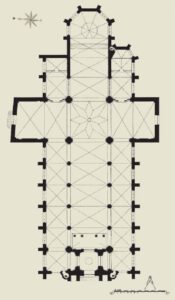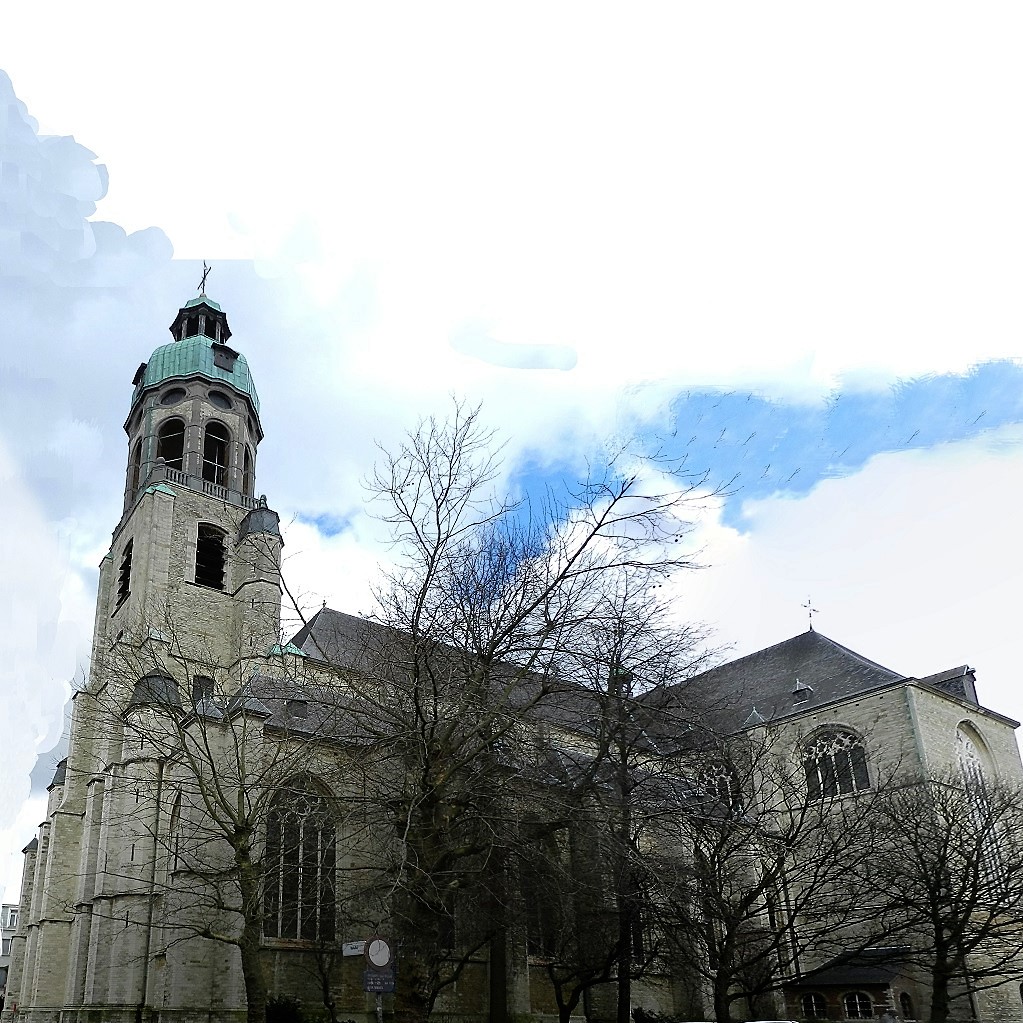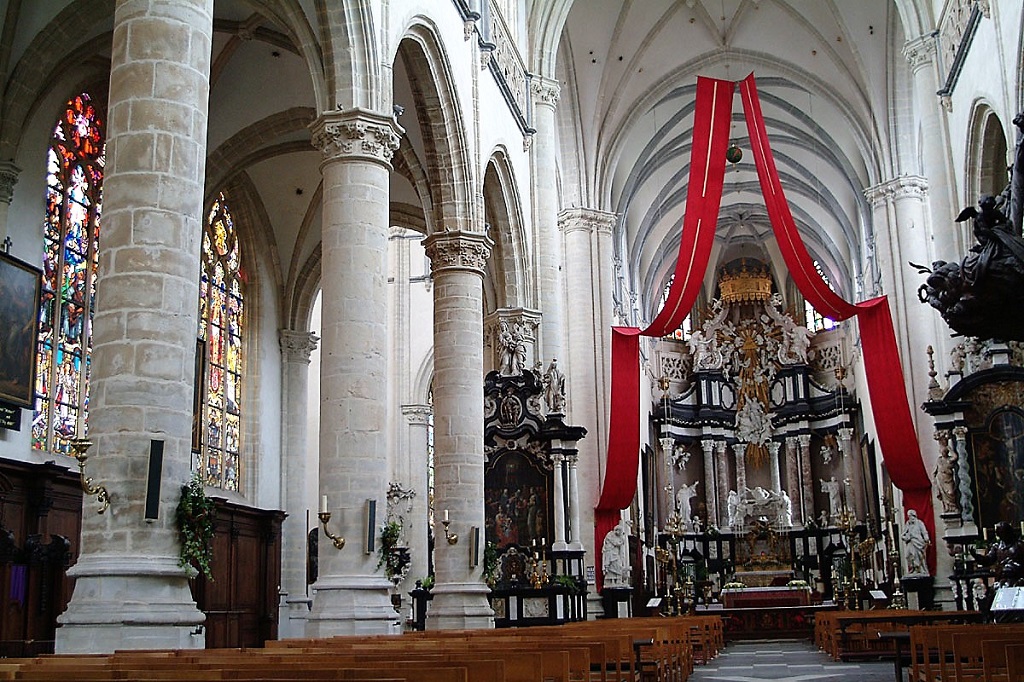Antwerp's St Andrew's Church, a revelation.
Spatial effect
Dimensions, style, symbolism and the angle of the light all contribute to the spatial effects of a church.
Dimensions
| Length: | 77 m (253 ft.), including the length of the choirIn a church with a cruciform floor plan, the part of the church that lies on the side of the nave opposite to the transept. The main altar is in the choir.: (26.5 m) 87 ft. |
| Width: | the central naveThe space between the two central series of pillars of the nave.: (11 m) 36 ft.; |
| the naveThe rear part of the church which is reserved for the congregation. The nave extends to the transept. and aisles: 23.5 m (77 ft.); | |
| the transepts: 42 m (138 ft.) | |
| Height: | the nave’s vaultings: ca. 21 m (69 ft.); |
| the crossing’s star vaulting: ca. 23 m (75 ft.) | |
| Tower: | 58 m (190 ft.) high; square brick base with inner sides measuring 5.5 m (18 ft.) each. |
Style
St Andrew’s was built in Gothic style, more specifically the local style variant – Brabantine Gothic –which can also be found in two churches built around the same time, St James’ and St Paul’s. Brabantine Gothic style characteristics of St Andrew’s include: the sober outside architecture, the triforium (which was only executed in the 19th century) with a parapet in front of each window of the clerestory, and the cylindrical columns on eight-sided pedestals, crowned with capitals bearing a cabbage leaf motive. The aisles are below rib vaultings, the crossingThe central point of a church with a cruciform floor plan. The crossing is the intersection between the longitudinal axis [the choir and the nave] and the transverse axis [the transept]. is set below a star vaulting, and the high altarThe altar is the central piece of furniture used in the Eucharist. Originally, an altar used to be a sacrificial table. This fits in with the theological view that Jesus sacrificed himself, through his death on the cross, to redeem mankind, as symbolically depicted in the painting “The Adoration of the Lamb” by the Van Eyck brothers. In modern times the altar is often described as “the table of the Lord”. Here the altar refers to the table at which Jesus and his disciples were seated at the institution of the Eucharist during the Last Supper. Just as Jesus and his disciples did then, the priest and the faithful gather around this table with bread and wine. below a fan vaulting.
Symbolism

In reference to the cross of Jesus, the church’s floor plan is shaped like a Latin crossA cross of which the lower part of the vertical beam is significantly longer than the upper part.; and in accordance with medieval tradition, the church is ‘oriented’ toward the east, referring to the symbolism of the rising sun. Until far into the 20th century, the celebration of the EucharistThis is the ritual that is the kernel of Mass, recalling what Jesus did the day before he died on the cross. On the evening of that day, Jesus celebrated the Jewish Passover with his disciples. After the meal, he took bread, broke it and gave it to his disciples, saying, “Take and eat. This is my body.” Then he took the cup of wine, gave it to his disciples and said, “Drink from this. This is my blood.” Then Jesus said, “Do this in remembrance of me.” During the Eucharist, the priest repeats these words while breaking bread [in the form of a host] and holding up the chalice with wine. Through the connection between the broken bread and the “broken” Jesus on the cross, Jesus becomes tangibly present. At the same time, this event reminds us of the mission of every Christian: to be “broken bread” from which others can live. only took place during the morning – thus, the faithful oriented themselves towards Christ, ‘the Light of the world’. Situated at the place of honour, the Lady Chapel
A small church that is not a parish church. It may be part of a larger entity such as a hospital, school, or an alms-house, or it may stand alone.
An enclosed part of a church with its own altar.
can be found on the right of the cross-shaped floor plan (at the north side, that is). In consequence, the altar at which Mary’s mother, Anna, is honoured, is against the northern crossing pillar in proximity to the Lady Chapel. Situated at the south side, the Venerable Chapel and the altar of the Holy Cross receive the full light of day, symbolizing the glorious love of Jesus. In love, Jesus was ready to sacrifice himself to the fullest (on the cross); hence, the altar of the Holy Cross is situated against the southern crossing pillar. This sacrifice of love is experienced as a living reality at the altar of the Holy SacramentIn Christianity, this is a sacred act in which God comes to man. Sacraments mark important moments in human life. In the Catholic Church, there are seven sacraments: baptism, confession, Eucharist, confirmation, anointing of the sick, marriage and ordination., of which the Last Supper is the theme.
Angle of the light
The light’s bright incidence is particularly aesthetic and playful, especially due to the stained glass windows. Several ‘surprise effects’ continue to keep visitors enthralled.
To become silent …

- Saint Andrew’s Church
- History and description
- Introduction
- The historical context
- Building history
- The patron saint
- The outbuildings
- The tower
- Spatial effect
- Saint Andrew’s identity card
- Saint Andrew in Art
- Saint Andrew in ‘his’ church
- The ancient high altar
- The current high altar
- Choir and chancel
- The choir stalls
- The celebration altar
- The Venerable Chapel
- The Mary Chapel
- The Minters’ Altar
- What is Truth?
- Holy Cross Altar
- Saint Anne’s Altar
- The pulpit
- The confessionals
- The organ
- Stained glass – southern aisle
- Stained glass – northern aisle
- The Way of the Cross
- Funeraria
- The treasury
- Bibliography


